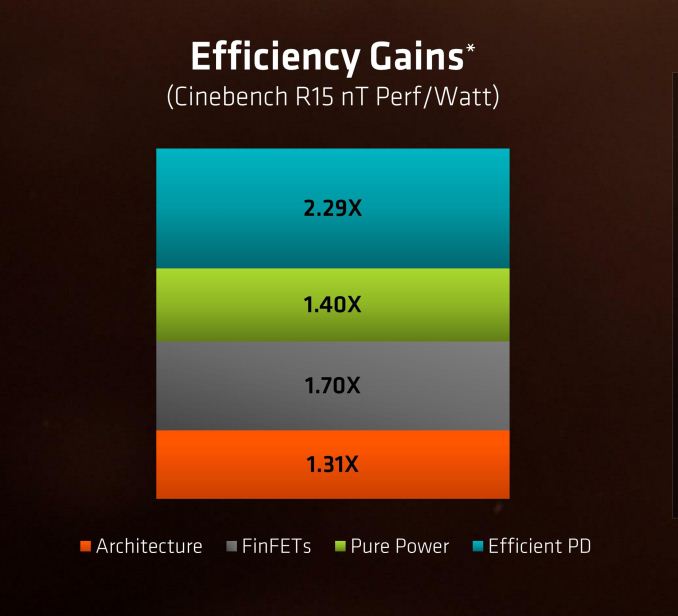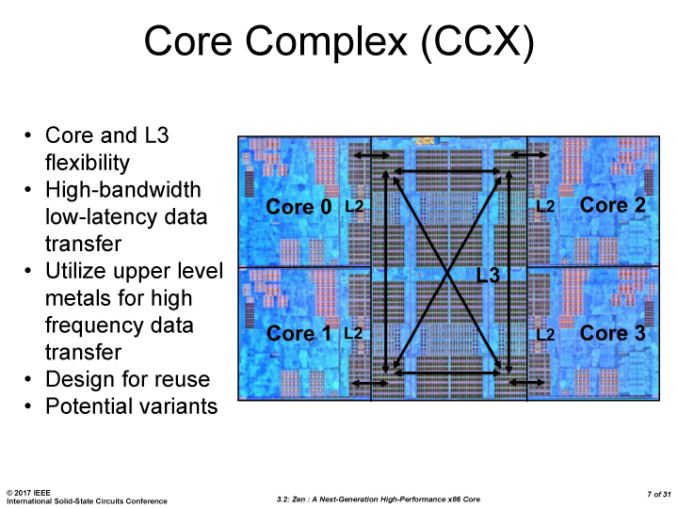The AMD Zen and Ryzen 7 Review: A Deep Dive on 1800X, 1700X and 1700
by Ian Cutress on March 2, 2017 9:00 AM ESTThe Ryzen Die
Throughout the time leading up to the launch of Ryzen, AMD reaffirmed its commitment to at least +40% IPC improvement over Excavator. This was specifically listed as a goal relating to performance, at an equivalent energy per cycle, resulting in a 40% increase in efficiency. At the Tech Day, AMD listed an overall 2.7x (or 270%) performance per watt improvement, split into the following:
Obviously a number of benefits come from moving the 28nm TSMC process to GloFo’s 14nm FinFET process which is used via a Samsung license. Both the smaller node and FinFET improvements have been well documented so we won’t go over them here, but AMD is stating that Zen is much more than this as a direct improvement to immediate performance, not just efficiency. While Zen is initially a high-performance x86 core at heart, it is designed to scale all the way from notebooks to supercomputers, or from where the Cat cores (such as Jaguar and Puma) were all the way up to the old Opterons and beyond, all with at least +40% IPC.
The first immediate image out of the presentation is the CPU Complex (a CCX), which shows the Zen core design as a four-CPU cluster with caches. This shows the L2/L3 cache breakdown, and also confirms 2MB of L3 per core with 8 MB of L3 per CCX. It also states that the L3 is mostly inclusive of the L2 cache, which stems from the L3 cache as a victim cache for L2 data. AMD is stating that the protocols involved in the L3 cache design allow each core to access the L3 of each other core with an average (but range) of latencies.
Over the next few pages, we’ll go through the slides. They detail more information about the application of Simultaneous Multithreading (SMT), New Instructions, the size of various queues and buffers, the back-end of the design, the front-end of the design, fetch, decode, execute, load/store and retire segments.














574 Comments
View All Comments
mapesdhs - Sunday, March 5, 2017 - link
Yet another example of manipulation which wouldn't be tolerated in other areas of commercial product. I keep coming across examples in the tech world where products are deliberately crippled, prices get hiked, etc., but because it's tech stuff, nobody cares. Media never mentions it.Last week I asked a seller site about why a particular 32GB 3200MHz DDR4 kit they had listed (awaiting an ETA) was so much cheaper than the official kits for Ryzen (same brand of RAM please note). Overnight, the seller site changed the ETA to next week but also increased the price by a whopping 80%, making it completely irrelevant. I've seen this happen three times with different products in the last 2 weeks.
Ian.
HomeworldFound - Sunday, March 5, 2017 - link
If they were pretty cheap then use your logic, placeholder prices happen. If they had no ETA the chances is that they had no prices. I don't see a shortage of decent DDR4 so it definitely isn't a supply and demand problem. Perhaps you need to talk to the manufacturer to get their guideline prices.HomeworldFound - Sunday, March 5, 2017 - link
Not really. If developers wanted to enhance AMD platforms, or it was actually worth it they'd have done it by now. It's now just an excuse to explain either underperformance or an inability to work with the industry.Notmyusualid - Tuesday, March 7, 2017 - link
@ sedraIt certainly should not be forgotten, that is for sure.
Rene23 - Monday, March 6, 2017 - link
yet people here mentioned multiple times "settled in 2009"; pretending it is not happening anymore, sick :-/GeoffreyA - Monday, March 6, 2017 - link
I kind of vaguely knew that benchmarks were often unfairly optimised for Intel CPUs; but I never knew this detailed information before, and from such a reputable source: Agner Fog. I know that he's an authority on CPU microarchitectures and things like that. Intel is evil. Even now with Ryzen, it seems the whole software ecosystem is somewhat suboptimal on it, because of software being tuned over the last decade for the Core microarchitecture. Yet, despite all that, Ryzen is still smashing Intel in many of the benchmarks.Outlander_04 - Monday, March 6, 2017 - link
Settled in 2009 .Not relevant to optimisation for Ryzen in any way
Rene23 - Monday, March 6, 2017 - link
settled in 2009 does not mean their current compiler and libraries are not doing it anymore, e.g. it could simply not run the best SSE/AVX code path disguised as simply not matching new AMD cpus properly.cocochanel - Saturday, March 4, 2017 - link
One thing that is not being mentioned by many is the increase in savings when you buy a CPU + mobo. Intel knows how to milk the consumer. On their 6-8 core flagships, a mobo with a top chipset will set you back 300-400 $ or even more. That's a lot for a mobo. Add the overpriced CPU. I expect AMD mobos to offer better value. Historically, they always did.On top of that, a VEGA GPU will probably be a better match for Ryzen than an Nvidia card, but I say probably and not certainly.
If I were to replace my aging gaming rig for Christmas, this would be my first choice.
mapesdhs - Sunday, March 5, 2017 - link
Bang goes the saving when one asks about a RAM kit awaiting an ETA and the seller hikes the price by 80% overnight (see my comment above).